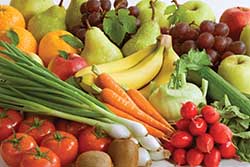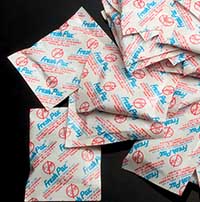Micro-oxygen: The Next Giant Step in Packaged Food Preservation
PACKAGING
 The January 2014 packaging column highlighted the latest technology of controlled atmosphere food preservation, which can be used for the chilled distribution of fresh fish fillets and prepared foods with potential to reach up to 100 days of shelf life. Although the article focused on the role of temperature as well as control of two key environmental gases, carbon dioxide and oxygen, it did not delve into the relative proportional contributions of the three components. Oxygen is a major biochemical deteriorative vector in foods, and most researchers have emphasized that depressed temperatures and elevated carbon dioxide are the most significant components in suppressing growth of aerobic microorganisms. Reduced oxygen assists in microbial growth rate control but plays even more important roles in other aspects of food preservation.
The January 2014 packaging column highlighted the latest technology of controlled atmosphere food preservation, which can be used for the chilled distribution of fresh fish fillets and prepared foods with potential to reach up to 100 days of shelf life. Although the article focused on the role of temperature as well as control of two key environmental gases, carbon dioxide and oxygen, it did not delve into the relative proportional contributions of the three components. Oxygen is a major biochemical deteriorative vector in foods, and most researchers have emphasized that depressed temperatures and elevated carbon dioxide are the most significant components in suppressing growth of aerobic microorganisms. Reduced oxygen assists in microbial growth rate control but plays even more important roles in other aspects of food preservation.
Rationale for Reducing or Removing Oxygen from Food
Several variables affect the quality of foods, such as microbial growth, enzymatic activity, moisture transfer, and oxidative and non-oxidative reactions. Even though foods may be microbiologically sterile due to heat treatment, as with canned/retorted or pasteurized foods, they still undergo biochemical deteriorative reactions. Oxygen in the headspace, dissolved and/or entrained in the food, and the gas that migrates from outside to the inside through the package structure are the principal sources of oxygen availability in contained food products. For instance, spoilage can be caused by enzymes that catalyze oxidative reactions as well as other biochemical adverse changes, such as lipid oxidation, protein oxidation, flavor oxidation, changes in color, and loss of nutritional value. Reducing oxygen should retard those reactions as well as other deteriorative reactions and help extend quality and shelf life.
Virtually all food products are subject to oxygen deterioration but some are more sensitive than others. Products such as orange juice, tomato sauce, chilled fresh meats, peanuts, peanut butter, seafood, beer, green vegetables, light-colored fruits, and salty snacks may benefit from technology that reduces or controls oxygen levels in and around food products.
Color Oxidation and Polyphenol Oxidase
Browning reactions in foods may be either non-enzymatic or enzymatic. Non-enzymatic browning, also known as the Maillard reaction, is the result of a chemical reaction that involves an amino compound, a reducing sugar, and water. The reaction is a nucleophilic attack by the nitrogen electrons of the carbonyl group of the open chain sugar. Water is lost and the ring closes, forming glycosamine. Then Amadori compound rearrangements take place to produce melanoidin (i.e., brown pigments), and Strecker degradation of other dicarbonyl compounds occur. This kind of browning does not require oxygen.
Enzymatic browning requires the presence of oxygen to take place. This kind of oxidation is seen in fruits such as bananas or apples, vegetables such as potatoes, and even seafood exposed to air. The fresh and minimally processed fruit and vegetable industries suffer very high economic losses due to browning, off-flavors, and overall loss of quality. The reaction involves a phenolic substrate and oxygen along with polyphenol oxidase, a copper-containing enzyme that catalyzes the reaction.
If any cell disruption occurs, as when a product suffers bruises, cuts, or mechanical damage, both the substrate and enzyme come into contact with atmospheric oxygen, producing browning. Polyphenol oxidase, which is also known as tyrosinase, phenolase, catechol oxidase, catecholase, o-diphenol oxidase, and monophenol oxidase, has the ability to react with different substrates. Polyphenol oxidase may be specific toward monophenolic and diphenolic substrates. The reaction consists of the hydroxylation of monophenols to o-diphenols by monophenolase or the hydroxylation of o-diphenols to produce o-quinones that polymerize to brown pigments non-enzymatically.
Polyphenol oxidase can be inactivated by heating foods. Inhibition may also be achieved by the use of ascorbic acid or other reducing agents. Non-specific binding of polyphenol oxidase with cyclodextrin or polyvinylpyrrolidone is partially effective to remove polyphenolic substrates. Decreasing the oxygen concentration by vacuum or inert gas flushing is common in the processing of juice, wine, red and cured meats, and snack foods.
The quantity to reduce oxygen to minimize browning to an acceptable level depends on the food product. Some modified atmosphere packaging studies have shown that reduction or elimination of oxygen to 5% or less is satisfactory to reduce polyphenol-oxidase activity, but other studies suggest that much lower oxygen does not eliminate or reduce browning in other fruit. In addition, intracellular air is present in fruit and vegetable tissues. This dissolved and entrained oxygen is responsible for deteriorative reactions, and levels below 100 parts per million are responsible for deterioration in fresh seafood and in thermally stabilized prepared foods. In beer, the levels of oxygen leading to adverse reactions are in parts per billion.
--- PAGE BREAK ---
Methods to Achieve Low Oxygen
To reduce oxygen levels in foods and extend the shelf life by retarding biochemical deteriorative reactions, the food packaging industry has created new packaging technologies. Reduction of oxygen levels during processing and packaging can be achieved by vacuum, controlled atmosphere packaging (CAP), or oxygen scavengers. CAP and vacuum offer packaging to oxygen-sensitive food but do not remove oxygen completely. Furthermore, oxygen that permeates through the packaging film or transmits through breaks cannot be removed by either of these techniques. On the other hand, oxygen scavenging technology absorbs residual oxygen after packaging. Iron powder oxidation, ascorbic acid oxidation, photosensitive dye oxidation, and enzymatic oxidation are some of the concepts used in oxygen scavenging systems. Most oxygen scavengers are iron-based:
Fe → Fe2+ + 2e-
½O2 + H2O + 2e- → 2OH-
Fe2+ + 2OH- → Fe(OH)2
Fe(OH)2 +¼ O2 + ½H2O → Fe(OH)3
 Oxygen permeable sachets can be used in dry products such as roasted nuts, coffee, jerky, and cereals; high fat products like potato chips; minimally processed foods like fresh and precooked pasta; meat and dairy products; bakery products like pizza crust, bread, cakes, cookies, and pastries; and beverages such as beer, fruit juice, and wine. Ageless® sachets by Mitsubishi Gas Chemical America (www.mgc-a.com/AGELESS) reduce oxygen levels to less than 0.01%. The necessary absorbent capacity can be calculated with the initial oxygen concentration at the moment of packaging as well as the oxygen permeability of the packaging material. Therefore a scavenging system with a higher capacity will ensure reduction of oxygen during distribution of the product. FreshPax® by Multisorb Technologies Inc., (www.multisorb.com) reduces oxygen levels to less than 0.01%. A new entry in this area is Oxy-Guard™ by Clariant (www.desiccants.clariant.com).
Oxygen permeable sachets can be used in dry products such as roasted nuts, coffee, jerky, and cereals; high fat products like potato chips; minimally processed foods like fresh and precooked pasta; meat and dairy products; bakery products like pizza crust, bread, cakes, cookies, and pastries; and beverages such as beer, fruit juice, and wine. Ageless® sachets by Mitsubishi Gas Chemical America (www.mgc-a.com/AGELESS) reduce oxygen levels to less than 0.01%. The necessary absorbent capacity can be calculated with the initial oxygen concentration at the moment of packaging as well as the oxygen permeability of the packaging material. Therefore a scavenging system with a higher capacity will ensure reduction of oxygen during distribution of the product. FreshPax® by Multisorb Technologies Inc., (www.multisorb.com) reduces oxygen levels to less than 0.01%. A new entry in this area is Oxy-Guard™ by Clariant (www.desiccants.clariant.com).
Other oxygen scavenging systems use an enzyme reactor surface that reacts with a substrate such as polypropylene or polyethylene to scavenge incoming oxygen. For example, glucose oxidase, an oxidoreductase, is used in bottled beer and wine to eliminate oxygen. Bioka Oxygen Absorbers (www.bioka.fi) reduces the oxygen concentration in the headspace to near 0%.
Besides sachets, oxygen scavengers may be incorporated directly into the packaging structure. The ingredients may be dispersed in a plastic, or the plastic may be made of a polymeric scavenger. Amosorb™ and Amosorb™SolO2 oxygen scavengers by Color Matrix (www.colormatrix.com) provide a shelf life of four to six months. It has been found that sachets have better absorbent capacity than systems with the scavenger incorporated in the packaging film. Scavengers may also be incorporated as flat packets, cards, sheets or adhesive labels, such as FreshMax® by Multisorb Technologies.
Other scavenging systems include ascorbic acid as an absorbent. Grace Darex® Packaging Technologies’ (www.gracedarex.com) oxygen-scavenging technology incorporates the scavenger into the package barrier as crown, plastic, or metal closures contain ascorbate that is oxidized to dehydroascorbic acid and sulphite to sulphate to protect beer from oxidation.
Oxygen Control to Reduce Food Waste
As the food industry removes or reduces fat, sodium, and sugar from foods in a quest to make products that are more healthful, there is often a severe downturn in the flavor, mouthfeel, and color of foods. Oxidation in vegetables and fruits and associated quality loss wastes food and hampers the industry’s efforts to get people, especially children, to eat more of these foods. Not only that, there is an abundance of evidence that shelf life is adversely affected. So as IFT celebrates 75 years of innovation, here is another challenge for the membership of IFT. What if food professionals took a different approach to quality loss during the processing of foods—before it goes into the package, is stored and distributed, and undergoes temperature cycling? Can the initial quality of foods be improved by applying micro-oxygen processing, thereby increasing the acceptability of these foods?
Acknowledgement: The authors thank Solandre Pérez Almeida, whose master’s thesis served as a source for this article.
 Aaron L. Brody, Ph.D., CFS, Contributing Editor
Aaron L. Brody, Ph.D., CFS, Contributing Editor
President and CEO, Packaging/Brody Inc., Duluth, Ga., and Adjunct Professor,
University of Georgia
[email protected]
Louise Wicker, Ph.D.,
Professor, University of Georgia
[email protected]
